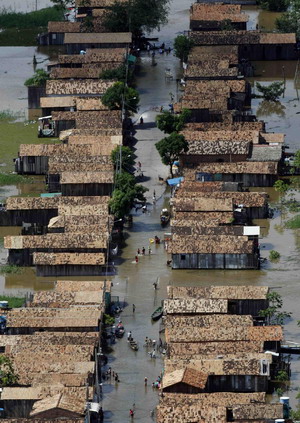Floods created a crater and a lake along the path of a key iron ore export railway that takes raw ingredient for steel from a jungle mine to an Atlantic port.

People stand outside their homes on streets flooded by the Tocantins river in Maraba, north of Brazil May 6, 2009. [Agencies]
|
The railway owner, Companhia Vale do Rio Doce SA, said in a statement it was working on repairs and would reopen the railway as soon as possible.
While the rainfall and floods are the worst that some parts of the region have seen since 1989, floods and mudslides last year in the southern state of Santa Catarina killed more than 100 people and displaced 80,000.
Meteorologists blamed the rains on an Atlantic weather system that typically moves on by April but has remained longer this year.
The system "is staying farther south from where it usually stays this time of the year," said Luiz Kondraski of Brazil's National Institute for Space Research. "If it were more to the north right now, the rains wouldn't be so intense."
One thing the rains won't hurt is Brazil's environment, said Paulo Adario, coordinator of Greenpeace's Amazon campaign.
"The rainforest and the animals that live in it have coexisted with floods for centuries," he said. "Floods are part of the annual cycle in the region."
Nor is it expected to have any impact on long-standing land and natural resource disputes between Indians and settlers, said Luiz Claudio Teixeira, a missionary and member of the Roman Catholic Church-backed Indian Missionary Council. nt in the region and will remain so with or without floods," he said. "They may lead to a temporary truce which will end as soon as the waters recede."
Meanwhile southern Brazil is in the midst of a severe drought blamed on the La Nina weather phenomenon, which lowers water temperatures in the Pacific Ocean.

